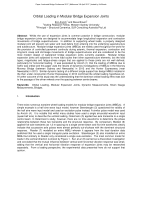Bridges

- Publication no: ABC2017-042-17
- Published: 20 April 2017
- PDF (free) Download
Whilst the use of expansion joints is common practice in bridge construction, modular bridge expansion joints are designed to accommodate large longitudinal expansion and contraction movements of bridge superstructures. In addition to supporting wheel loads, a properly designed modular joint will prevent rain water and road debris from entering into the underlying superstructure and substructure.
Modular bridge expansion joints (MBEJs) are widely used throughout the world for the provision of controlled pavement continuity during seismic, thermal expansion, contraction and long-term creep and shrinkage movements of bridge superstructures and are considered to be the most modern design of waterproof bridge expansion joints currently available. Modular bridge expansion joints are subjected to more load cycles than other superstructure elements, but the load types, magnitudes and fatigue-stress ranges that are applied to these joints are not well defined, particularly for horizontal loading.
It was postulated by Ancich that the loading of MBEJs due to traffic was orbital and this paper uses the results of dynamics investigations of MBEJs in the Mooney Mooney Bridge (between Sydney and Newcastle) in 2012 and the Hunter Expressway (near Newcastle) in 2013. Similar dynamic testing of a different single support bar design MBEJ installed in the then under construction Hunter Expressway in 2013 confirmed the orbital loading hypothesis.
A further outcome of this study was the understanding that the dominant orbital loading effect was due to the passage of the driven wheels over the spacing between centre beams.
